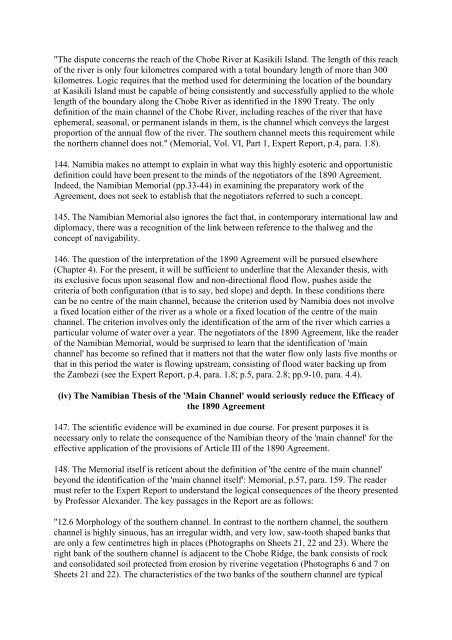botswana/namibia - Cour international de Justice
botswana/namibia - Cour international de Justice
botswana/namibia - Cour international de Justice
Create successful ePaper yourself
Turn your PDF publications into a flip-book with our unique Google optimized e-Paper software.
"The dispute concerns the reach of the Chobe River at Kasikili Island. The length of this reach<br />
of the river is only four kilometres compared with a total boundary length of more than 300<br />
kilometres. Logic requires that the method used for <strong>de</strong>termining the location of the boundary<br />
at Kasikili Island must be capable of being consistently and successfully applied to the whole<br />
length of the boundary along the Chobe River as i<strong>de</strong>ntified in the 1890 Treaty. The only<br />
<strong>de</strong>finition of the main channel of the Chobe River, including reaches of the river that have<br />
ephemeral, seasonal, or permanent islands in them, is the channel which conveys the largest<br />
proportion of the annual flow of the river. The southern channel meets this requirement while<br />
the northern channel does not." (Memorial, Vol. VI, Part 1, Expert Report, p.4, para. 1.8).<br />
144. Namibia makes no attempt to explain in what way this highly esoteric and opportunistic<br />
<strong>de</strong>finition could have been present to the minds of the negotiators of the 1890 Agreement.<br />
In<strong>de</strong>ed, the Namibian Memorial (pp.33-44) in examining the preparatory work of the<br />
Agreement, does not seek to establish that the negotiators referred to such a concept.<br />
145. The Namibian Memorial also ignores the fact that, in contemporary <strong>international</strong> law and<br />
diplomacy, there was a recognition of the link between reference to the thalweg and the<br />
concept of navigability.<br />
146. The question of the interpretation of the 1890 Agreement will be pursued elsewhere<br />
(Chapter 4). For the present, it will be sufficient to un<strong>de</strong>rline that the Alexan<strong>de</strong>r thesis, with<br />
its exclusive focus upon seasonal flow and non-directional flood flow, pushes asi<strong>de</strong> the<br />
criteria of both configuration (that is to say, bed slope) and <strong>de</strong>pth. In these conditions there<br />
can be no centre of the main channel, because the criterion used by Namibia does not involve<br />
a fixed location either of the river as a whole or a fixed location of the centre of the main<br />
channel. The criterion involves only the i<strong>de</strong>ntification of the arm of the river which carries a<br />
particular volume of water over a year. The negotiators of the 1890 Agreement, like the rea<strong>de</strong>r<br />
of the Namibian Memorial, would be surprised to learn that the i<strong>de</strong>ntification of 'main<br />
channel' has become so refined that it matters not that the water flow only lasts five months or<br />
that in this period the water is flowing upstream, consisting of flood water backing up from<br />
the Zambezi (see the Expert Report, p.4, para. 1.8; p.5, para. 2.8; pp.9-10, para. 4.4).<br />
(iv) The Namibian Thesis of the 'Main Channel' would seriously reduce the Efficacy of<br />
the 1890 Agreement<br />
147. The scientific evi<strong>de</strong>nce will be examined in due course. For present purposes it is<br />
necessary only to relate the consequence of the Namibian theory of the 'main channel' for the<br />
effective application of the provisions of Article III of the 1890 Agreement.<br />
148. The Memorial itself is reticent about the <strong>de</strong>finition of 'the centre of the main channel'<br />
beyond the i<strong>de</strong>ntification of the 'main channel itself': Memorial, p.57, para. 159. The rea<strong>de</strong>r<br />
must refer to the Expert Report to un<strong>de</strong>rstand the logical consequences of the theory presented<br />
by Professor Alexan<strong>de</strong>r. The key passages in the Report are as follows:<br />
"12.6 Morphology of the southern channel. In contrast to the northern channel, the southern<br />
channel is highly sinuous, has an irregular width, and very low, saw-tooth shaped banks that<br />
are only a few centimetres high in places (Photographs on Sheets 21, 22 and 23). Where the<br />
right bank of the southern channel is adjacent to the Chobe Ridge, the bank consists of rock<br />
and consolidated soil protected from erosion by riverine vegetation (Photographs 6 and 7 on<br />
Sheets 21 and 22). The characteristics of the two banks of the southern channel are typical

















